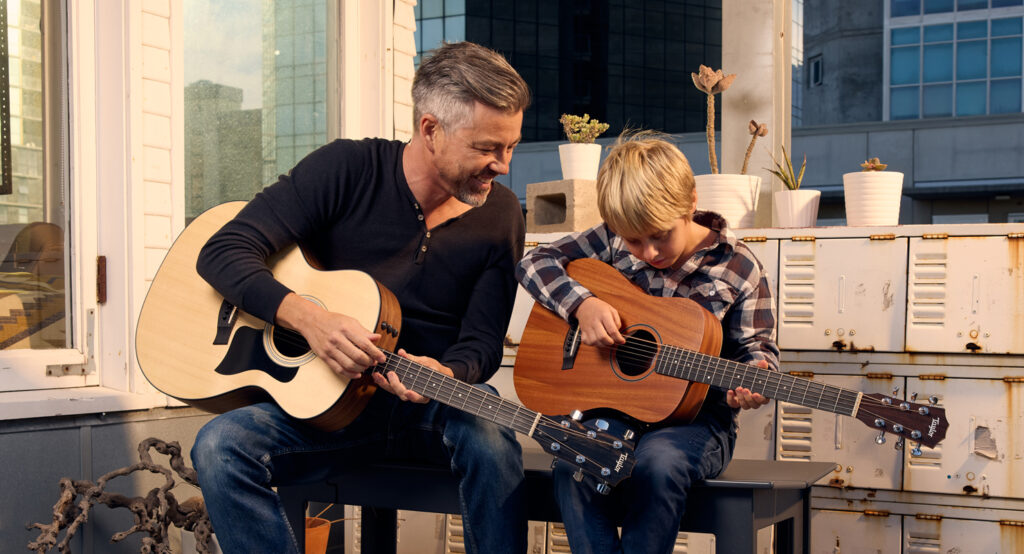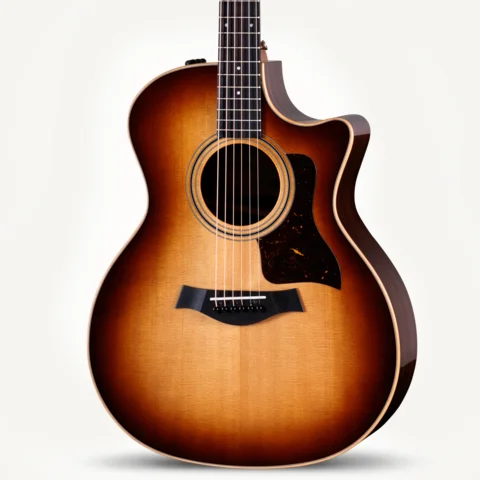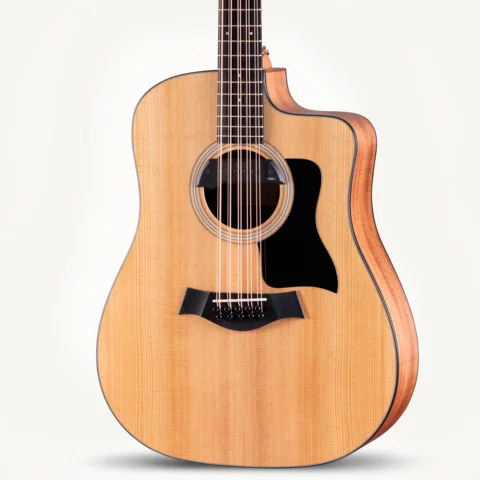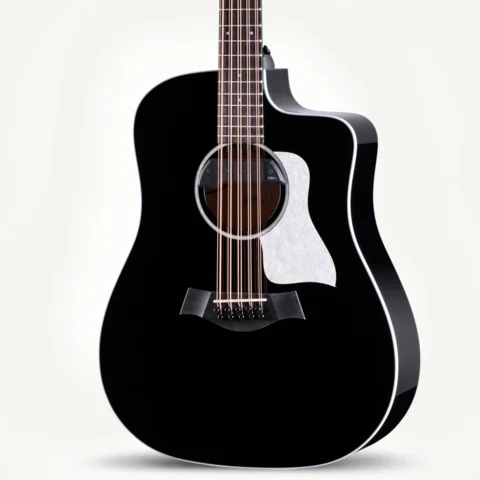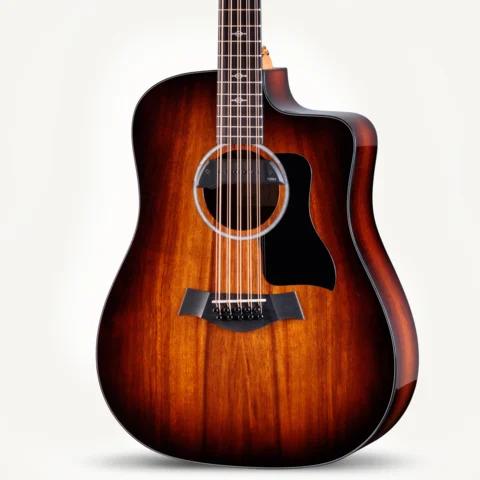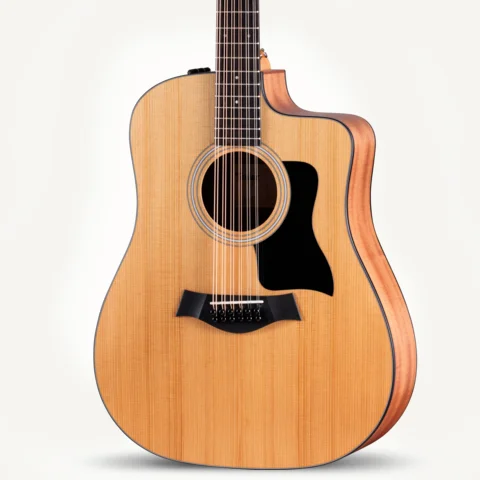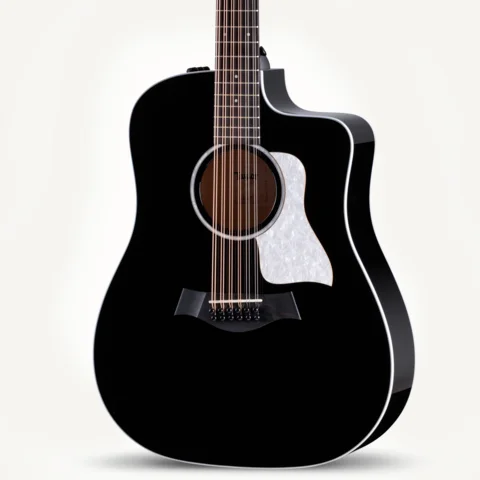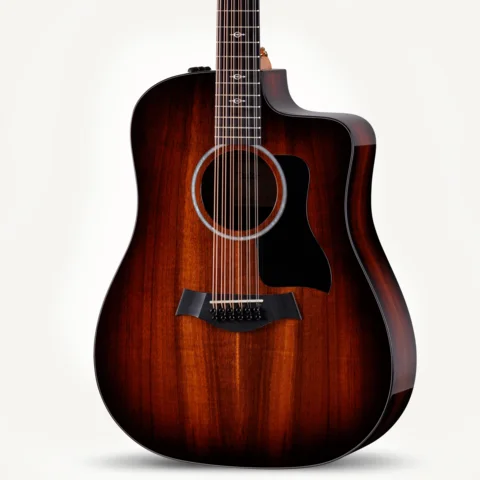When it comes to picking out an acoustic guitar, body shape is key. Far from being just an aesthetic choice, an acoustic guitar’s body defines its sound and relationship with the player. But with dozens of different names, sizes, and silhouettes, finding a body style that complements your unique needs can seem overwhelming.
At Taylor Guitars, we believe that every player deserves to be paired with a guitar that inspires them and elevates their musical experience. With that in mind, we’ve created this guide to explore our different acoustic guitar shapes.
Why Body Shape Matters
The design of an acoustic guitar’s body makes a big difference. For instance, size and shape affect the sound of the guitar and influence the way it fits with the player.
When strumming the strings of an acoustic guitar, the ensuing vibrations cause the top of the body (also called the soundboard) to resonate, amplifying and coloring the sound of the strings. The dimensions of the body define the boundaries of these vibrations, which in turn determines the sound.
The size of the guitar body type also relates to the volume of air within the instrument. Changes to the air capacity of the body will emphasize specific frequencies. A smaller body will have a more focused sound centered on higher frequencies, while a larger body will produce deeper low-end frequencies. Bigger-bodied acoustic guitars also tend to be louder than their smaller counterparts, although there are always exceptions.
When it comes to the relationship between the guitar and the player, size and shape play an important role, too. When you sit, the depth and position of the waist change where the guitar rests on your lap. A wider body will have more distance between the edge of the guitar and the strings, which can mean a stretch if you have shorter arms.
With this in mind, shorter players may find smaller-bodied guitars to feel more comfortable. Although, size should never be a restriction in your search for the right guitar. Remember, there are no hard and fast rules, so try as many shapes and sizes as you can when looking for the perfect fit—don’t limit yourself from the start.
Acoustic Guitar Body Shapes
With such a variety of acoustic guitar body shapes out there, how do you find your perfect match? Let’s take a closer look at the different silhouettes you’ll come across.
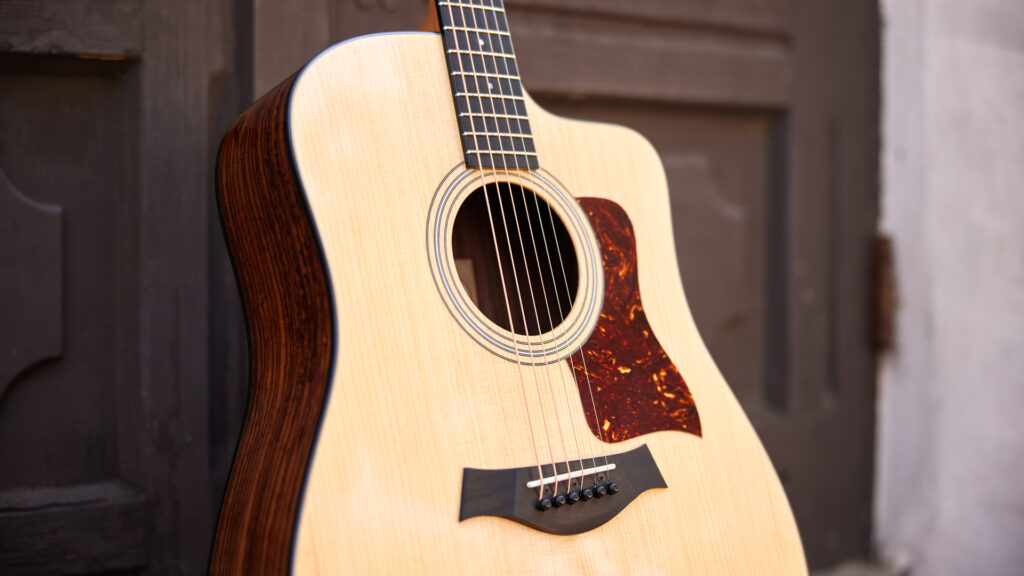
Dreadnought
The dreadnought guitar has a classic, traditional shape, invented in 1916 to shine through in big band and orchestra settings without amplification. These guitars are characterized by a wider waist and square shoulders. A dreadnought will sound reasonably balanced, with robust lows, snappy mids, and brilliant highs.
In terms of fit, the wide waist of the dreadnought shape places the guitar a little higher up in a seated player’s lap. Its traditional look and feel will be especially at home in folk or bluegrass music, but its sound translates well across the musical spectrum. If you like to flatpick and dig in while playing, this may be the guitar for you.
To explore the dreadnought guitar shape further, have a look at some of the most popular models, including:
- The beginner-minded Academy 10
- The 210ce Plus, a dreadnought with a cutaway
- The 150e, a 12-string guitar with onboard electronics
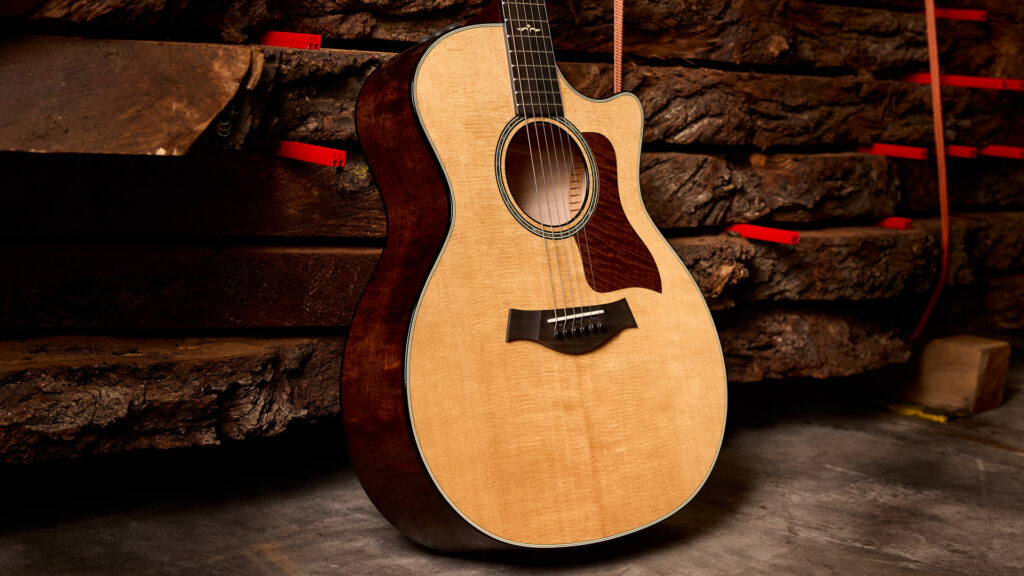
Grand Auditorium Guitar
The Grand Auditorium (GA), first introduced in 1994 by Bob Taylor, is most often thought of as the Taylor guitar. Take the dreadnought shape, narrow the waist slightly, and you have a Grand Auditorium. Pinching the waist takes away some of the low-end boominess, making way for a defined, balanced sound.
Whether you like to strum or fingerpick, the versatile GA is your best friend—especially if you’re a generalist who plays a bit of everything. These guitars are favored by amateurs and professionals alike to record, play live, and practice in the living room. You’ll likely feel right at home with a Grand Auditorium.
For a simple GA-style guitar with a built-in pickup, try the 114e. Or join the likes of the Zac Brown Band and take the 614ce for a spin—a Grand Auditorium with a cutaway to help you reach those high frets.
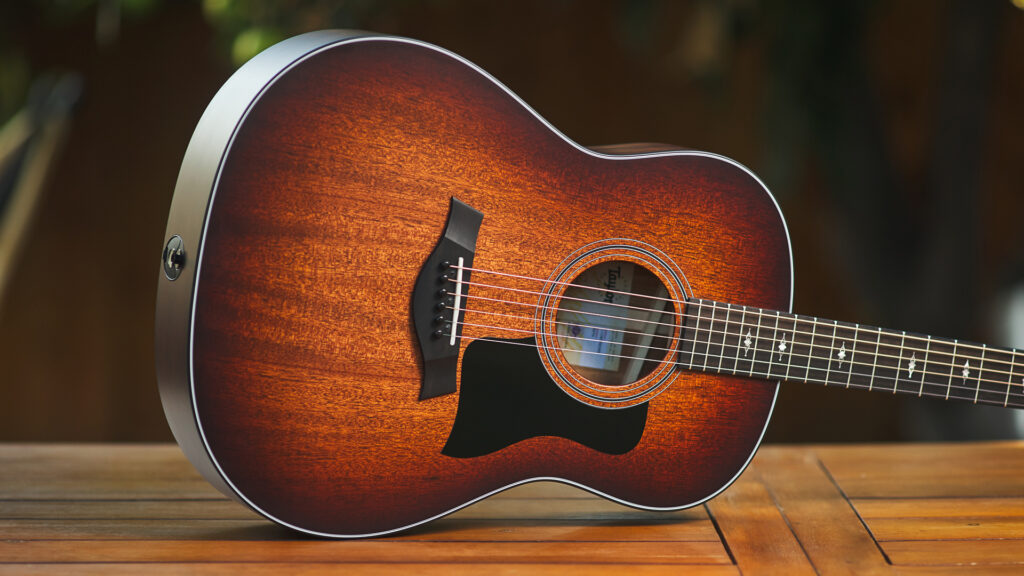
Grand Pacific
The Grand Pacific (GP) offers a round-shoulder variation of the more square-shoulder dreadnought shape. The subtle curves give you the warm sound of a dreadnought, without the “woofy” characteristic in the midrange, expanding its musical versatility.
A prominent factor in the distinct sound of the GP is our V-Class bracing technology, used to coax more volume and sustain out of the guitar than traditional X bracing. The Grand Pacific’s overall tone is one of rounded highs and lows, with a thick, well-defined middle.
As soon as you play a Grand Pacific, you can tell its sound was inspired by the warmth of classic acoustic guitar recordings. These guitars are ideal for gentle strumming and fingerpicking, but they’re practical in almost any scenario.
If you’re a dreadnought fan looking for something slightly different, the Grand Pacific may be the answer. Check out the brilliant simplicity of the AD17 or the beautiful mahogany top of the 327e.
Grand Concert
Unveiled in 1984, the Grand Concert (GC) shape is our smallest on offer, with narrow shoulders and a tapered waist. Its compact size translates to a lower volume ceiling, and it lacks the boominess you might find in dreadnoughts and other larger body styles. Instead, you’ll find the GC to have an incredibly controlled sound.
One of the appeals of the GC body style is comfort—its narrow waist places the guitar nice and low in your lap when seated. It also boasts a 24-7/8″ scale length (slightly shorter than average), which creates a slinky handfeel on the strings.
For those who want to take their small guitar experience to another level, the GC is also offered as a 12-Fret. This refers to where the neck meets the body of the guitar. On a 12-Fret model, shaping chords and bending the strings is even easier. You can still find the GC offered as a 14-Fret if that’s more your style.
The Grand Concert is ideal for fingerpickers and light strummers, especially those who prefer a smaller guitar. For recording and live band settings, the GC is perfect, as its focused sound won’t overtake a mix.
Here are some of our Grand Concert recommendations:
- For the budding guitar player who wants a built-in pickup and tuner, there’s the Academy 12e
- Fans of mahogany’s warm tones will love the 522ce
- Brilliant sound meets playability in the 312ce 12-Fret
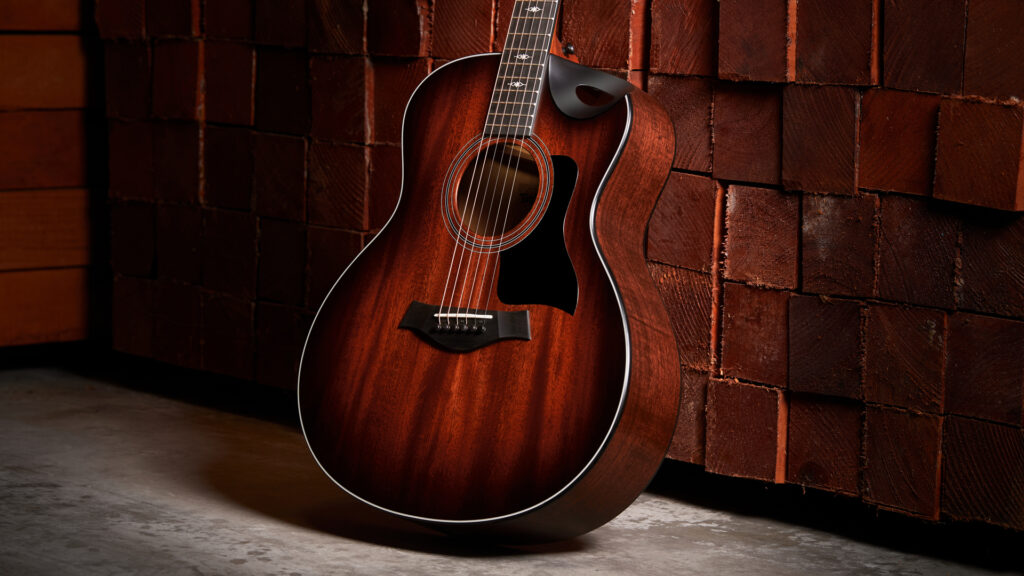
Grand Symphony
Designed in 2006 by Bob Taylor and updated by master builder Andy Powers in 2020, the Grand Symphony (GS) is a sonic tour de force. Take a Grand Auditorium, push the waist up and out, slightly increase the size of the lower bout, and you have the GS. The added real estate translates to more volume and bass than some smaller options listed above, and its V-Class bracing guarantees superb intonation.
One of the most striking features of the Grand Symphony is the soundport cutaway, which gives it an expressive, reverberant sound. If you like a lush, symphonic surround-sound experience with thick trebles and rich sustain, look no further.
For a large-bodied guitar, the GS handles heavy strumming and light fingerpicking with ease thanks to its 24-7/8″ scale length and light-gauge strings. It’s a brilliant, responsive instrument for the dynamic player who runs through several styles in one performance.
For examples of the Grand Symphony shape, explore the bold 326ce or the dazzling, all-koa K26ce.
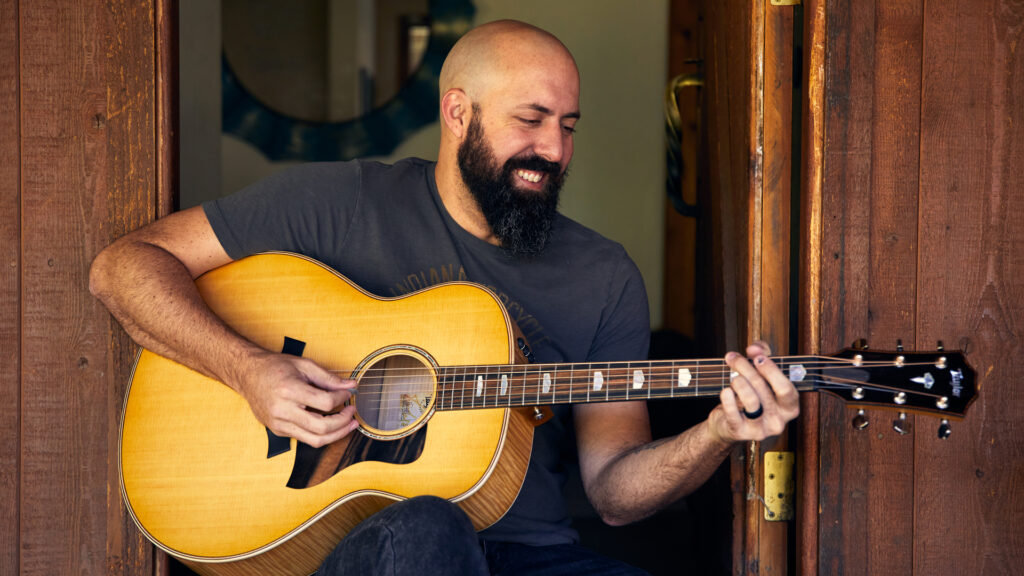
Grand Orchestra
The Grand Orchestra (GO) is a modern take on the Jumbo acoustic guitar, with its wide lower bout and 5-inch body depth from the soundhole. An immense body like this brings an immense sound, and while you’d be right to expect booming bass from this shape, it doesn’t overshadow the mids and treble. With the Grand Orchestra, it’s all about balance and singing sustain.
Unlike traditional Jumbo-esque guitars, the GO is surprisingly touch-sensitive. It doesn’t take a heavy hand to coax brilliant top-end from these guitars. That’s not to say you can’t get aggressive with a Grand Orchestra, though—in fact, it may be one of the most dynamically versatile big guitars out there. The GO is especially recommended for players who tune down.
If the Grand Orchestra style is calling you, you can’t go wrong with the 618e or the 818e.
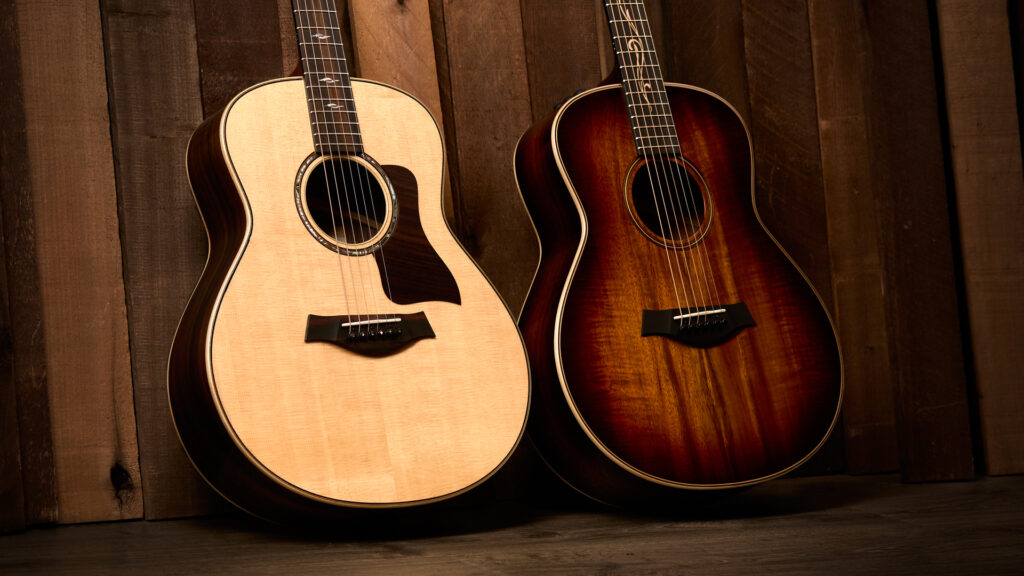
Grand Theater
Want enormous sound without the footprint? The Grand Theater (GT) is the answer. With a shorter body length and a reduced depth, the GT shape is built to deliver rich, powerful tone in a compact package. The Grand Theater’s bass response is robust for its size, and the highs are crisp and clear.
The GT was designed for the modern player—its accessible size allows you to easily carry extraordinary tone with you. Its 24-1/8″ scale length makes forming chords and bending strings as easy as can be. Whether you’re on your way to the studio or camping out under the stars, you can have a light, portable instrument without compromising on the sound you want.
For a terrific-sounding guitar responsibly sourced from urban wood, try the GT Urban Ash. Or, if you like onboard electronics and beautiful solid koa, there’s the GT K21e.

Travel Guitars
Although “travel guitar” isn’t necessarily defined by a specific body shape, these instruments are worth including in the conversation. The travel guitar category is more about overall proportions than the silhouette, as you’ll find these scaled-down guitars in many of the shapes we’ve explored.
Due to their diminutive size, travel guitars are quieter, less bassy, and more trebly than a full-sized guitar. But don’t be fooled by their scale—their tone and projection can keep up with the pack. Travel guitars are perfect for smaller players or the guitarist on the go. Their size makes them easy to play, no matter your ability or location.
For proof that good things come in small packages, take a look at the gorgeous GS Mini Rosewood or the pint-size Baby Mahogany (BT2e) with its built-in pickup and tuner.
Find Your Perfect Acoustic Guitar Body Shape
Your biggest takeaway should be that acoustic guitar bodies come in all shapes and sizes, and there’s one out there for every style, every application, and every player. And with so much variety, all it takes is a little experimentation to discover your perfect fit.
Finding the 6 string acoustic guitar that suits your style is a journey we’re intimately familiar with. If you have any questions about the guitar shapes we offer at Taylor, we’d love to hear from you.

























